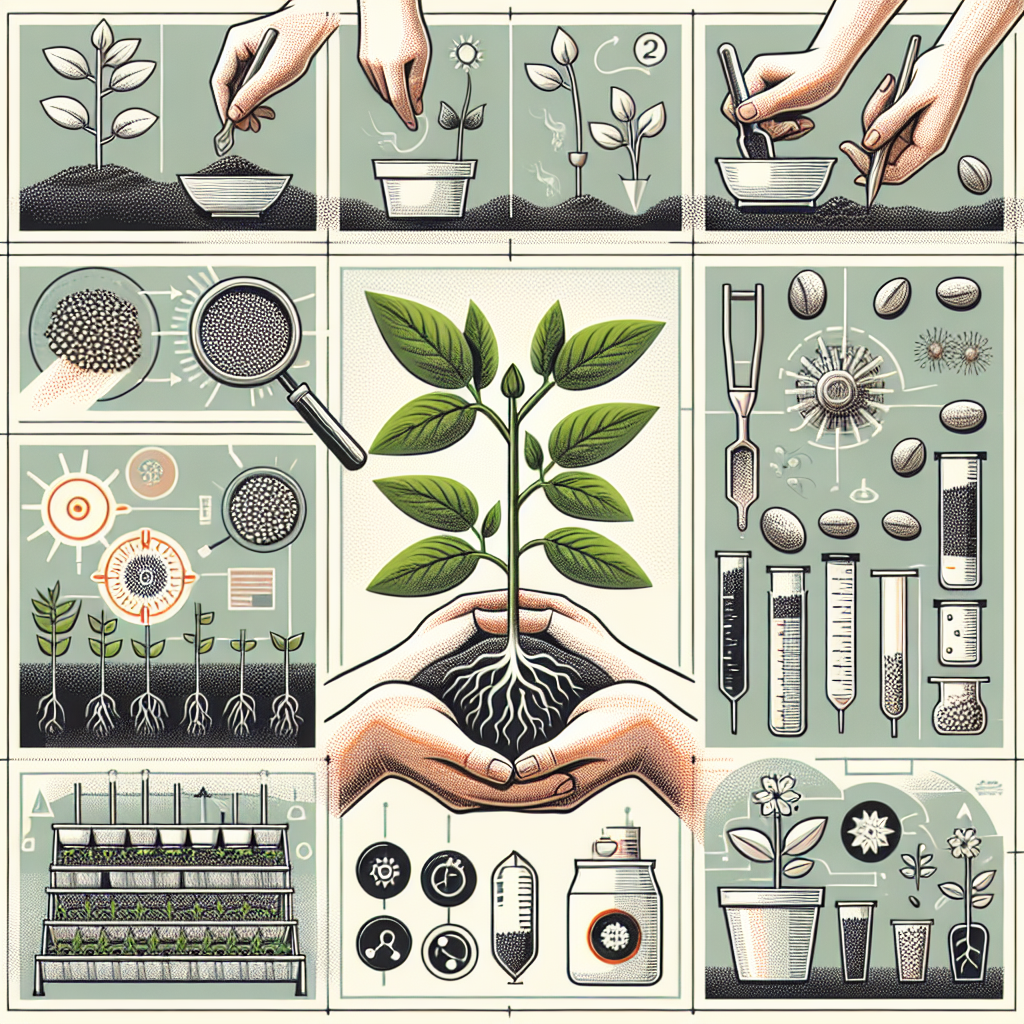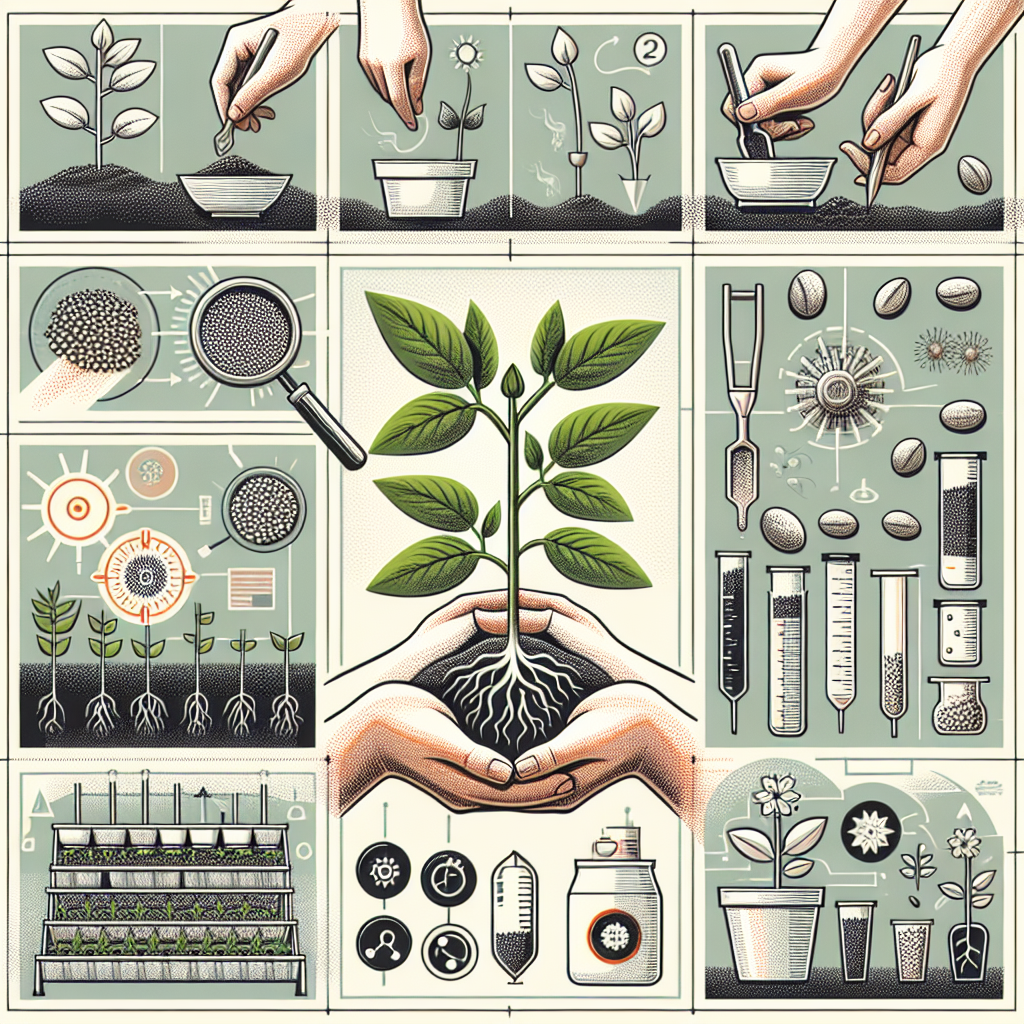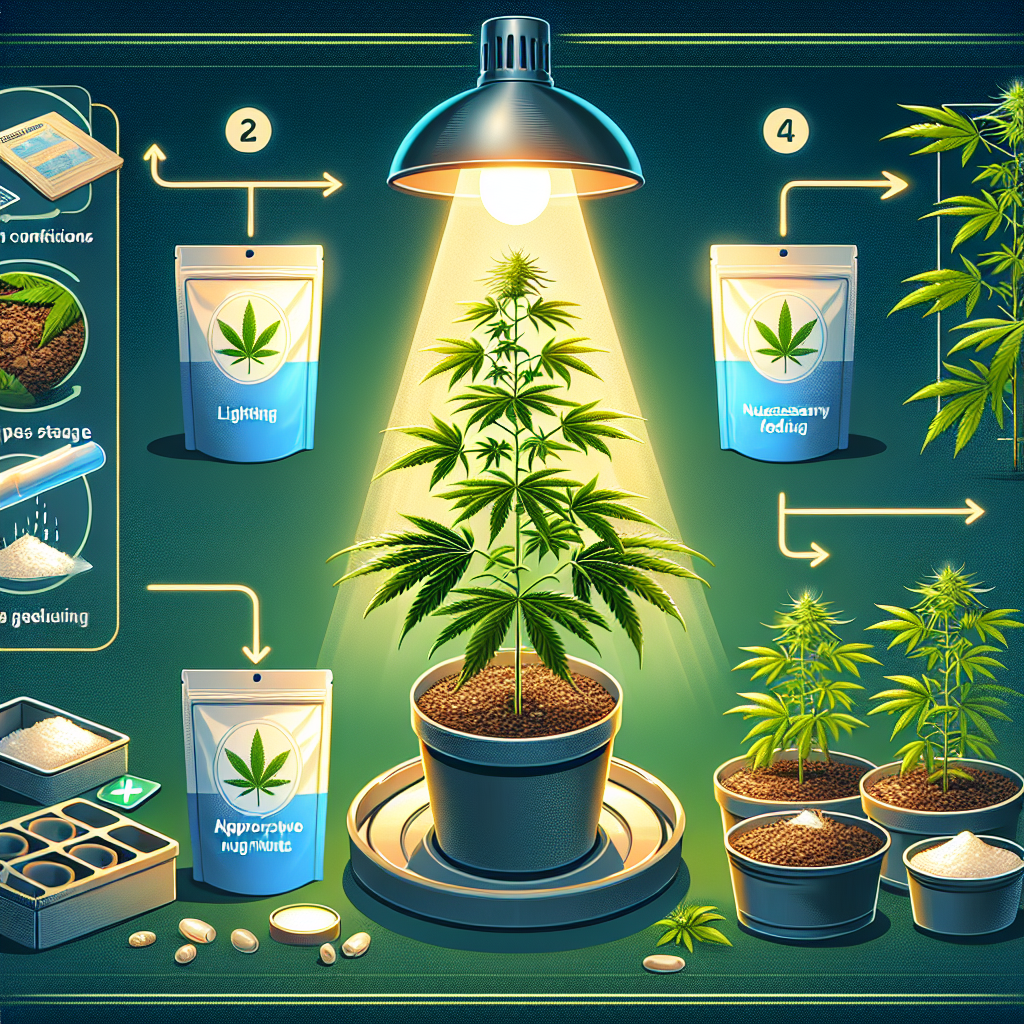7 Steps To Grow Cannabis

Alright folks, hold onto your hats because we’re about to embark on a green-fingered adventure! In our uproariously entertaining article, aptly named “7 Steps To grow Cannabis,” we’ll be divulging the secrets of growing your own stash of nature’s finest herb. Get ready to laugh, learn, and maybe even discover your green thumb along the way. So, buckle up and let’s embark on a journey that’ll have you growing cannabis like a pro in no time! But remember, this article is purely for entertainment purposes, and if you’re looking for genuine advice, maybe consult an actual expert. Cheers!
Choosing the Right Cannabis Strain
Ah, choosing the perfect cannabis strain, a decision that is as exciting as it is overwhelming. With so many options available, it can be quite the task to find the ideal strain for our preferences and goals. But fear not, fellow cannabis enthusiasts, for we are here to guide you through this marijuana maze.
Understanding Different Cannabis Types
First things first, let’s get acquainted with the different types of cannabis. We have Indica, Sativa, and hybrids. Indica strains are known for their relaxing and sedative effects, perfect for melting away stress and getting a good night’s sleep. Sativa strains, on the other hand, offer an energizing and uplifting high, great for socializing and staying active. And hybrids? Well, they are a delightful blend of both Indica and Sativa, offering a balanced experience.
Considering Personal Preferences and Goals
When it comes to choosing a cannabis strain, personal preferences and goals play a crucial role. Are we looking for deep relaxation, pain relief, or just a fun and giggly time with friends? Determining what we want from our cannabis experience will help narrow down the options. Do we prefer the body high of an Indica or the cerebral buzz of a Sativa? Maybe a hybrid that offers both is the way to go. Whatever our desires may be, there is a strain out there waiting to be our perfect match.
Setting Up the Growing Space
Now that we have our strain in mind, it’s time to set up the perfect growing space for our little green buddies. Whether it’s indoors or outdoors, we want to create an environment that nurtures their growth and ensures their success.
Selecting an Indoor or Outdoor Environment
Indoor or outdoor, that is the question. Growing cannabis indoors gives us full control over the environment, allowing us to manipulate factors like lighting, temperature, and humidity. This is especially beneficial if we live in an area with unpredictable weather or need privacy. On the other hand, growing outdoors allows our plants to bask in the glorious sunlight and soak up all the natural goodness that Mother Nature provides. It’s really a matter of personal preference and the resources we have available.
Determining Space Requirements
Before we start planting those precious seeds, we need to make sure we have enough space for them to thrive. Cannabis plants can range in size depending on the strain and growing conditions. Whether it’s a small closet, a dedicated grow tent, or a spacious backyard, we must ensure that there is enough room for the plants to grow without being cramped or hindered in any way.
Creating Optimal Lighting Conditions
Just like humans, plants need light to flourish. When growing indoors, it’s essential to provide them with an adequate light source. Good ol’ Mother Nature’s sunlight is ideal, but if that’s not possible, artificial lights like LED or high-pressure sodium (HPS) can work wonders. The intensity and duration of light exposure play a vital role in the growth and development of cannabis plants, so we must choose wisely.
Ensuring Proper Ventilation and Airflow
Proper ventilation is key to maintaining a healthy growing environment for our cannabis plants. Good airflow helps prevent the buildup of moisture, reduces the risk of mold and mildew, and aids in the exchange of gases that plants require for photosynthesis. Proper ventilation can be achieved through the use of fans, exhaust systems, and intake vents, ensuring our plants have a constant flow of fresh air.
Setting Up Temperature and Humidity Controls
Just like us, cannabis plants have specific temperature and humidity preferences. A comfortable temperature range for our green companions is between 70-85°F (21-29°C) during the day and slightly cooler at night. As for humidity, aim for around 50-60% during the vegetative stage and lower it to 40-50% during flowering. Investing in a digital thermometer and hygrometer combo will help us keep tabs on these vital factors, ensuring our plants are cozy and content throughout their growth.

Germinating Cannabis Seeds
Now that our growing space is all set up, it’s time to get those tiny cannabis seeds ready for their journey towards becoming magnificent plants. Germination is the process of waking up these dormant seeds and encouraging them to sprout and open up their potential.
Obtaining High-Quality Seeds
Ah, the seed hunt begins! We must ensure we have high-quality cannabis seeds to give our plants the best start possible. There are numerous seed banks and breeders out there, each offering their own unique selection of strains. Do our research, read reviews, and purchase from reputable sources to ensure the seeds we get are of excellent quality and genetics.
Using the Paper Towel Method
One popular germination method is the trusty ol’ paper towel method. It’s simple and effective. Grab a few damp (not soaking wet) paper towels, place the seeds in between them, and gently fold the paper towels over. Seal them in a plastic bag and keep them in a warm and dark place. Check on them every day, keeping the paper towels moist but not soaking. In a few days, the seeds should crack open and show their tiny roots. At this point, they are ready for transplantation.
Using the Water Method
Another popular germination method is the water method. Fill a glass with distilled water at room temperature, drop the seeds in, and let them soak for about 24-48 hours. Check on them occasionally to ensure they are submerged and not floating. After the soaking period, transfer the sprouted seeds to a moist paper towel or directly to a transplantation container. Just like that, our seeds have embarked on their journey to grow into glorious cannabis plants.
Transplanting Seedlings
Now that our seeds have sprouted, it’s time to give them a new home where they can spread their roots and grow strong. Transplanting seedlings is a delicate process that requires care and attention to ensure minimal disturbance and maximum growth potential.
Preparing the Transplanting Containers
When it comes to choosing the right transplanting containers, we have a variety of options at our disposal. Whether it’s biodegradable pots, plastic containers with drainage holes, or good ol’ fabric pots, the key is to select a container that provides ample room for the roots to spread and allows for proper drainage. Fill the containers with a high-quality potting mix, preferably one specifically formulated for cannabis plants.
Transferring Seedlings with Care
When our seedlings have developed a few sets of true leaves and have a sturdy stem, they are ready to be transplanted. Gently loosen the soil around the seedling’s roots, making sure not to damage them. Plant the seedling in its new container, ensuring it is at the same depth as it was in the previous one. Gently pat down the soil to provide stability and support.
Providing Adequate Light and Moisture
After transplanting, our little seedlings need some TLC to ensure they continue thriving. Place them in an environment with the same lighting conditions and adequate moisture as before the transplant. If growing indoors, make sure the lights are at the appropriate distance to prevent burning the delicate leaves. Water the seedlings with care, making sure not to overwater or underwater them. Strike the perfect balance, and watch those little ones grow into strong and healthy cannabis plants.

Nurturing Cannabis Plants
Our cannabis plants are in their adolescence now, growing taller and stronger each day. But they still need our love and attention to reach their full potential. Nutrients, watering, pruning—let’s dive into the nurturing process.
Feeding with Balanced Nutrients
Just like any living beings, cannabis plants need their fair share of nutrients to grow healthy and strong. Choosing the right nutrients and maintaining a balanced feeding schedule is crucial. There are plenty of nutrient options available in the market, both chemical and organic. Whichever we choose, following the recommended dosage and staying vigilant for any signs of nutrient deficiencies or excesses will ensure our plants get the nourishment they need.
Providing Sufficient Watering
Water, the elixir of life for our green companions. Finding the right balance when it comes to watering cannabis plants is vital. Overwatering can suffocate the roots and cause root rot, while underwatering can lead to stunted growth and nutrient deficiencies. To avoid these pitfalls, water your plants when the top layer of the soil feels dry, making sure to water thoroughly and allowing any excess water to drain out. Pay attention to the plants’ behavior and adjust the watering schedule accordingly.
Managing pH Levels
Ah, the pH scale, a cannabis grower’s best friend. Maintaining the proper pH levels in the soil or growing medium is crucial for nutrient uptake. Cannabis plants prefer a slightly acidic environment, with a pH ranging from 6.0 to 6.5. Investing in a pH meter or pH testing kit will make it easier for us to monitor and adjust the pH levels of our plant’s growing medium as needed.
Supporting Plant Growth with Pruning
Just like a bonsai artist carefully trims and shapes their tree, we too can work our magic on cannabis plants through pruning. Pruning helps promote healthy growth and maximizes yield potential. Removing dead or dying leaves, trimming lower branches for better airflow and light penetration, and training the plant into desired shapes are all part of the pruning process.
Implementing LST and HST Techniques
If we’re feeling a bit adventurous in our cannabis-growing journey, we can dive into the world of Low-Stress Training (LST) and High-Stress Training (HST) techniques. LST involves gently bending and tying down branches to create a more even canopy and promote even light distribution. HST, on the other hand, involves more drastic methods like topping or super cropping to manipulate the plant’s growth pattern. Proceed with caution, fellow growers, and always research and understand these techniques before attempting them.
Identifying and Preventing Common Issues
Even in the most lovingly nurtured gardens, problems can still arise. Pests, diseases, nutrient deficiencies—these unwelcome guests can wreak havoc on our precious cannabis plants. It’s essential to arm ourselves with knowledge and know how to address these issues promptly.
Recognizing Pests and Diseases
Pests and diseases are the nightmare scenarios every cannabis grower hopes to avoid. From spider mites to powdery mildew, there are countless pests and diseases that can infest our plants. Familiarizing ourselves with the symptoms and signs of these culprits will help us catch them early and take the necessary steps to eradicate them.
Applying Appropriate Pest Control Methods
When pests come knocking on our cannabis plants’ door, it’s time to show them the exit. There are various pest control methods available, both organic and chemical. Organic solutions like neem oil, diatomaceous earth, or ladybugs can help battle pests while keeping the environment as pristine as possible. However, severe infestations may require more intensive methods, and chemical pesticides may need to be used as a last resort.
Addressing Nutrient Deficiencies and Excesses
Just as we, humans, need our vitamins and minerals to stay healthy, so do our cannabis plants. Nutrient deficiencies can manifest in various ways, from discolored leaves to stunted growth. Identifying which nutrient is lacking or in excess is essential in addressing these issues. Adjusting the nutrient feeding schedule or using specific fertilizer blends will help correct any deficiencies and rebalance the plant’s nutritional requirements.
Dealing with Environmental Stressors
Sometimes, despite our best efforts, our cannabis plants can still encounter environmental stress. Heatwaves, sudden temperature fluctuations, excessive humidity, or harsh weather conditions can all impact their growth and overall health. Providing temporary shade, increasing airflow, or implementing additional temperature and humidity controls will assist our plants in weathering these rough patches.
Flowering and Harvesting Cannabis Plants
Ah, the time has come for our plants to show off their flower power. The flowering stage is when the magic happens, and those beautiful buds we’ve been dreaming of start to blossom. Knowing when and how to harvest them at their peak potency is key.
Determining When to Switch to Flowering Stage
For our photoperiod cannabis plants, the transition from the vegetative stage to the flowering stage is triggered by manipulating their light cycle. To initiate flowering, we need to switch to a 12/12 light cycle, meaning 12 hours of uninterrupted darkness and 12 hours of light. However, autoflowering cannabis plants will start flowering regardless of the light cycle.
Understanding Light Cycles for Flowering
During the flowering stage, our cannabis plants have specific light requirements. While they need light to photosynthesize, they also need uninterrupted darkness to trigger the flowering process. Providing them with 12 hours of light and 12 hours of complete darkness is crucial to maintaining their flowering cycle and maximizing bud production.
Monitoring Trichome Development for Harvesting
The trichomes, those tiny resinous glands that cover the buds and leaves, hold the key to harvesting our cannabis plants at their peak potency. As the flowering stage progresses, the trichomes change color, indicating the ideal time to harvest. Using a magnifying glass or a jeweler’s loupe, we can observe the trichomes and determine the optimal time to harvest based on their color and density.
Properly Drying and Curing Buds
Harvesting is just the first step towards enjoying the fruits of our labor. After harvesting our cannabis plants, it’s essential to dry and cure the buds properly to preserve their flavors and potency. Hang the harvested buds in a cool, dark, and well-ventilated area, maintaining a temperature of around 60-70°F (16-21°C) and humidity levels between 45-55%. Once the buds have dried to the desired moisture level, they can be transferred to an airtight container to cure, allowing the flavors to develop further.
Post-Harvest Care
When it comes to post-harvest care, our focus shifts from the plants to the glorious, resinous buds they have blessed us with. Trimming, manicuring, and curing are all vital steps to enhance the flavor, aroma, and potency of our cannabis.
Trimming and Manicuring the Buds
Trimming and manicuring the buds is like giving them a luxurious spa treatment. Removing excess leaves, stems, and any unwanted material will enhance the overall appearance and smokeability of the buds. Whether we choose to go for a wet trim or a dry trim, the goal is to create visually stunning, resin-loaded buds that are a pleasure to behold.
Curing Cannabis for Enhanced Flavor and Potency
The final step in post-harvest care is the holy grail of cannabis enthusiasts—a proper cure. Curing involves storing the dried buds in airtight containers, such as glass jars, and allowing them to age gracefully. This process allows for the breakdown of chlorophyll, resulting in smoother smoke and a more enjoyable flavor profile. Patience is key during the curing stage, as it typically takes a few weeks to several months to reach cannabis connoisseur-level quality.
Understanding Cannabis Laws and Regulations
As responsible cannabis growers, it’s crucial to navigate the ever-changing landscape of cannabis laws and regulations. Different regions and countries have different rules, and staying informed is paramount to avoid any legal headaches.
Researching Local and National Laws
Before embarking on our cannabis-growing journey, we must thoroughly research the laws and regulations regarding cannabis cultivation in our area. These laws can vary significantly, even within states or provinces, so it’s crucial to know what is allowed and what is not. Stay updated with any recent changes, so we can grow our cannabis plants with peace of mind.
Obtaining Necessary Licenses and Permits
In some regions, obtaining licenses and permits to grow cannabis is mandatory. These licenses and permits help ensure that the cultivation is done legally and ethically, following all regulations and standards. If required, be sure to apply for and obtain all the necessary licenses and permits before starting our cannabis cultivation adventure.
Exploring Advanced Growing Techniques
For those of us who strive for greatness and want to take our cannabis-growing skills to the next level, there are advanced growing techniques waiting to be explored. From hydroponics to CO2 enrichment and everything in between, let’s dive into the world of cannabis cultivation possibilities.
Understanding Hydroponics and Aeroponics
Hydroponics and aeroponics are soilless growing techniques that provide plants with highly oxygenated nutrient solutions. These methods offer precise control over nutrient delivery and high yields, making them popular choices for advanced growers. In hydroponics, the plant’s roots are directly immersed in the nutrient-rich solution, while in aeroponics, they are suspended in an oxygenated mist.
Exploring the Potential of CO2 Enrichment
Ah, the sweet embrace of carbon dioxide (CO2), the key ingredient for photosynthesis. By enriching our grow space with additional CO2, we can boost the growth and yield of our cannabis plants. High levels of CO2 allow the plants to photosynthesize more efficiently, resulting in faster growth and larger buds. However, it’s crucial to maintain proper ventilation and airflow to prevent an excessive buildup of CO2.
Utilizing Supercropping and Screen of Green (ScrOG)
Supercropping and the Screen of Green (ScrOG) are techniques used to maximize light exposure and create an even canopy. Supercropping involves gently bending and manipulating the branches to create more horizontal growth, maximizing light penetration. ScrOG, on the other hand, utilizes a screen or net to train the plant’s branches horizontally, creating an even canopy and promoting bud development. These techniques take some practice and finesse, but the rewards are well worth the effort.
And there you have it, fellow cannabis cultivators! We’ve covered everything from choosing the right cannabis strain to exploring advanced growing techniques. May your cannabis-growing journey be filled with joy, laughter, and bountiful harvests. Happy growing!
cannabis Cannabis Cultivation Growing Horticulture Indoor Gardening



